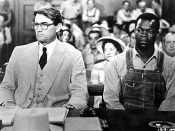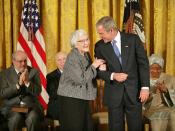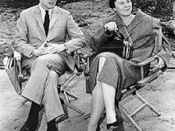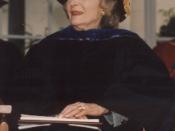To Kill a Mockingbird, by Harper Lee, takes place in the 1930's in the calm atmosphere of the small southern town of Macomb, located in the red clay hills of Alabama. Miss Lee portrays her characters through the innocent eyes of a child named Scout. With the usage of this first-person narrative technique, the reader is able to clearly see the facts for himself and to gain an insight into the inequities and injustices running through the prejudice and discrimination surrounding the town.
Lee builds to the major climax of the story by involving the characters in many smaller conflicts in building toward the culmination of events. The initial conflict is seen with the introduction of the character, Arthur "Boo"ÃÂ Radley. Mr. Radley "ÃÂs reputation has been established by the town gossips as being that of an alarming and a frightening man. In fact, even his nickname of "Boo"ÃÂ gives credence to the attitude that the townspeople possess toward him.
Even though Scout has the same feelings toward Mr. Radley, she also has feelings of pity toward him. Her father, Atticus Finch, had always told her "not to judge a person until he has walked in their skin."ÃÂ This conflict is resolved when "Boo"ÃÂ comes to the aid of the Finch children, and the townspeople realize that he is a decent, honest, and thoughtful man.
Harper Lee carries the reader through the normal daily activities of the town as she builds to the climax of the book. She frequently mentions the children's attempts to catch a glimpse of "Boo"ÃÂ Radley and of their strong desire to know him as a person. Once, "Boo"ÃÂ, unbeknownst to the children, appears and performs a kind thoughtful act for them. They were chilled by the night air when they stood and watched Miss Maudie's house burn. Due to their fascination with the clouds of smoke and fiery flames, they were not even aware when "Boo"ÃÂ placed a warm blanket around their shoulders. Purposefully, Harper Lee keeps "Boo"ÃÂ and the children continually in our minds in her steps toward building to the climax of the story.
The conflict of the townspeople against Atticus Finch is revealed when he is appointed to defend the black man, Tom Robinson, against the rape charges filed by Mayella Ewell. The people of Macomb, with their deeply planted roots of prejudice and discrimination, rise together against Atticus. They brand him as a "nigger-lover"ÃÂ and refuse to acknowledge his obligation to defend the black man against the rape charges. Even during the lunch mob scene when the vigilantes try to seize Tom Robinson from the jail, Atticus is firm in his belief of the man's innocence and manages to stop their attempts. Atticus does effectively prove Tom Robinson's innocence, but the jury ignores this and casts their vote for the man to die. Further, the conflict within Atticus himself is seen as he wrestles with his conscience in a passionate struggle to do what is right for the accused and what is right for his family. His conflicting emotions show his deep love for his children and his strong sense of justice.
The conflict of Tom Robinson versus the town is also revealed in the trial scene as the townspeople intentionally overlook the fact that his withered arm was not capable of striking and injuring the Ewell girl. Their only thoughts of Tom are that he is black, and they are white. In their eyes, a white man can do no wrong and a black man is the root of all evil. Atticus feels very despondent because the values he has worked to instill within his children of justice and truth are being ignored because of the powerful influence of hate and bigotry.
The townspeople resolve their conflict with Tom Robinson, though, by killing him when he attempts to escape from the jail. Seemingly unconcerned, they settle back into their daily lives as though nothing has ever happened. But Harper Lee jolts the reader when she presents the conflict of Bob Ewell against that of Atticus Finch. Atticus had destroyed his credibility during the trial, and Ewell had vowed to murder the Finch children. They are saved by "Boo"ÃÂ Radley, and Bob Ewell falls upon his own knife that he had intended for the children. His assassin is himself and all of his hatred and evil thoughts that he possesses.
Jem and Scout Finch now fully understand the meaning of their father's wise words, "Mockingbirds don't do one thing but make music for us to enjoy. That is why it's a sin to kill a mockingbird."ÃÂ Atticus was attempting to convey to his children the fact some people such as "Boo"ÃÂ Radley and Tom Robinson is victims of our society. They are innocent simple people who don't bother anyone and should have the right to be left to their own solitude. "Boo"ÃÂ is a good man who has harmed no one, but is made the butt of countless jokes. Tom, also, has inflicted no wrongs upon anyone, but is chastised for the fact that he is black.
Harper Lee develops the plot of her book, To Kill a Mockingbird, very fluidly through a series of minor conflicts, a climax, and its resolution. The words of justice, prejudice, and discrimination take on new meaning through Lee's telling of the story of two young children and two innocent men who are the victims of the evil of the world.





